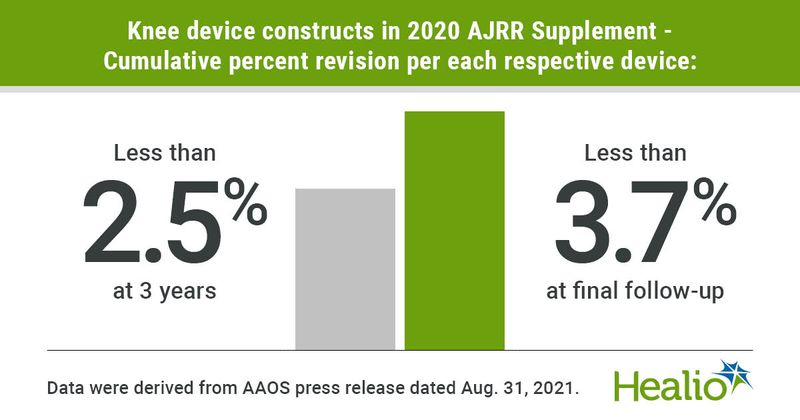Reports from shoulder and elbow, joint arthroplasty registries highlight trends, outcomes
Clinical data reports for joint arthroplasty and shoulder and elbow procedure registries released at the American Academy of Orthopaedic Surgeons Annual Meeting may guide physician and patient decision-making and improve orthopedic care.
The reports are published by the AAOS Registry Oversight Committee, according to a press release.

The 2020 American Joint Replacement Registry (AJRR) Annual Report Supplement consists of data submitted to the AJRR by 1,110 institutions through June 2020 and cover procedures performed from 2012 to 2019, while the AAOS Shoulder & Elbow Registry (SER) 2020 Annual Report highlighted key aspects of the latest procedural data entered in the registry that were collected from 2015 to 2020. The SER data establish survivor curves, track revisions and support orthopedic care and best practices, according to the release.
William J. Maloney, MD, FAAOS, chair of the AAOS Registry Oversight Committee, said in the release, “The number of anatomical areas and procedures covered continues to grow and the data being submitted by participating sites is paving the way for improved orthopedic outcomes in the United States. We are pleased to publish these clinical insights from the AJRR and the SER and look forward to seeing continued growth and increasingly impactful analyses in the years ahead.”
Regarding the AJRR supplement, this is the second consecutive year in which the supplement includes reporting of device-specific cumulative percent revision estimates that are drawn from the registry’s linkage with CMS claims data, according to the release. In addition, analyses in the 2020 supplement were expanded to include more devices than the 2019 report. The latest analysis examines cumulative all-cause revision at target timepoints with further stratification of devices based on fixation and bearing descriptions, according to the release.
For example, all hip device constructs included in the analysis had a cumulative percent revision of less than 2.7% at 1 year and less than 4.6% at final follow-up for each respective device. Knee device constructs that were included were found to have less than 2.5% cumulative percent revision at 3 years and less than 3.7% at final follow-up for each respective device.
“The AAOS Shoulder and Elbow Registry is one of the most important endeavors being undertaken in shoulder and elbow surgery,” Stephen F. Brockmeier, MD, FAAOS, SER Steering Committee member, said in the release. “This data will drive future clinical care, answer critical questions and contribute to research in the field, and dramatically enhance our ability to provide optimal outcomes for our patients. As can be seen in the 2020 SER Annual Report, the registry data continue to accumulate at a rapid pace, and new procedures are added for study each year.”
To date, more than 112 U.S. facilities, including hospitals, private practices and ASCs in 35 states participate in the SER, according to the press release.
References:
www.aaos.org/registries/publications/ajrr-annual-report/
www.aaos.org/registries/publications/ser-annual-report/

